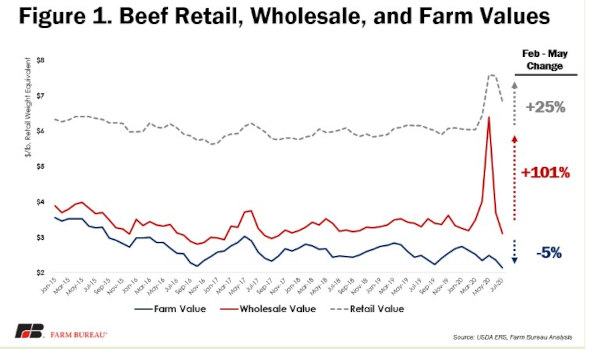AFBF'S Market Intel series has
examined the impact that
COVID-19 has had on
livestock,
beef and pork markets over the
course of the pandemic. Food production was significantly disrupted, especially at livestock processing facilities, where labor shortages and worker protection measures slowed throughput at plants around the country and even caused some facilities to temporarily shut down. As a result, there was a sharp increase in the wholesale value of beef and pork that coincided with a rapid decline in the value of live animals, creating a record “live-to-cutout-spread,” which is the difference between the price that is paid for the live animal and the wholesale price of the processed animal product.
During this disruption, one area that has received less attention is the spread between the price of beef and pork leaving the processing sector and the price that consumers pay at the grocery store. Part of the reason for this is the time lag between when prices are paid and when data becomes available for analysis. However, we now have several months’ worth of data to examine and piece together a picture of the impact of COVID-19 on meat price spreads.
The Data
USDA’s Economic Research Service compiles monthly average values and the differences among those values at the farm, wholesale and retail stages of the production and marketing chain for selected cuts of beef and pork. Retail prices are from the Bureau of Labor Statistics’ Consumer Price Index. Wholesale and farm prices are from USDA's Agricultural Marketing Service. Conversion factors developed by ERS are used to convert retail weight to a carcass-weight equivalent. ERS calculates its price spreads on a per-pound-of-retail-product basis. It takes 2.40 pounds of the standard steer to produce a pound of retail beef and 1.14 pounds of wholesale beef to produce a pound of retail beef. For hogs, the conversion factors are 1.869 pounds of hog per pound of retail cuts and 1.04 pounds of wholesale cuts per pound of retail cuts. The gross farm values in the price spread tables are the farm price of live animals multiplied by the farm-to-retail conversion factor. The wholesale values are the average price of the animal's wholesale meat cuts times the wholesale-retail conversion factor. High price spreads can often lead to frustration at various sectors of the supply chain, from disgruntled producers experiencing declining shares to angry consumers facing higher prices at the meat case. Increasing price spreads can inflate retail prices and deflate farm prices.
Beef
Figure 1 shows the retail, wholesale and farm values of beef on a retail weight equivalent. The impact of COVID-19 is evident in the retail and wholesale values’ spike during late spring 2020. (It is important to keep in mind that these are monthly data, so the weekly variations that we have addressed in other articles are harder to distinguish.) However, as previously discussed, the shortage in processing capacity and the backlog of animals in the processing pipeline did not bump up the price of cattle. Instead, prices at the wholesale level shot up more than 100%, while retail prices climbed 25%. Farm-gate prices, on the other hand, dropped 5%. Keep in mind that these values have all been converted to a retail equivalent value, so they may not reflect the same magnitude seen in other reports.

Figure 2 examines the spreads between the farm, wholesale and retail values shown in Figure 1. A price spread is essentially the difference between the cost of an item at two different stages of the marketing channel. It can also be viewed as the costs and profits of the marketing system that moves the product from the farm to the processor to the consumer. Figure 2 shows three spreads: the farm-to-wholesale spread, as denoted by the red bars, the wholesale-to-retail spread, as denoted by the blue bars, and the farm-to-retail spread, the combination of the red and blue bars. For beef, COVID-19 resulted in the highest levels for all three price spreads since the data was first collected in 1970. The farm-to-retail price spread peaked in June at $5.21/lb retail weight equivalent. Also peaking in June was the wholesale-to-retail spread, at $3.86/lb retail weight equivalent. However, the farm-to-wholesale spread peaked in May at $3.90/lb retail weight equivalent.
Pork
The pork complex experienced a similar spike to beef, albeit at a lower magnitude. Figure 3 shows three spreads: the farm-to-wholesale spread, as denoted by the red bars, the wholesale-to-retail spread, as denoted by the blue bars, and the farm-to-retail spread, the combination of the red and blue bars. COVID-19 resulted in record levels for all three price spreads for pork since the data was first collected 50 years ago. The pork farm-to-retail price spread peaked in June at $3.65/lb retail weight equivalent. Also peaking in June was the wholesale-to-retail spread, at $2.84/lb retail weight equivalent. However, the farm-to-wholesale spread peaked in May at $1.19/lb retail weight equivalent.
Farmer’s Share
The data also gives us the ability to calculate the producer’s share of the overall retail dollar. Figure 4 shows us the producer’s share of the retail dollar over the last 20 years for both beef and pork. Since 2000, the producer’s share of the beef retail dollar has averaged 47%, while the producer’s share for pork has averaged 27%. However, the value of both animal proteins has been trending downward over the last several years, dragging the average producer’s share down to 42% over the last three years for beef and 21% over the last three years for pork. Of course, this decline started before COVID-19, but the pandemic has exacerbated this issue, resulting in record lows for producer’s shares of the retail dollars. At 31%, beef producers experienced a record monthly low in June. Pork did not experience an absolute record low, but at 14%, it was near the record low of 12.3% (experienced in December of 1998) and is certainly the lowest in the last 20 years.